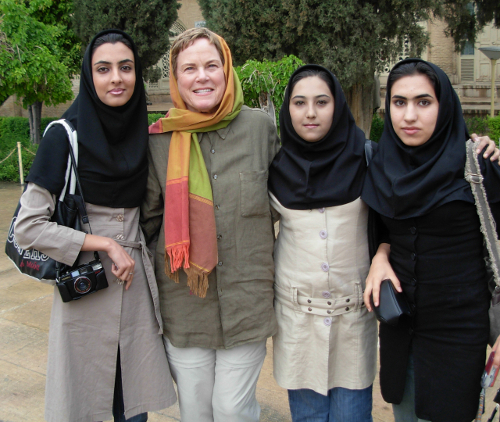Iran Fashion Report
By Cecelia Thorner
Iran Fashion Report
Religious Clothing Rules Restrict
Iranian Women’s Fashion
I waited impatiently for my visa to arrive before our trip to Iran in April 2007. You can imagine my trepidation about seeing myself with a scarf covering my hair and neck-it was a requirement for the visa as well as what I would be wearing while on the trip. My first glimpse of what it means to succumb to such stringent, religious-based restrictions on personal dress and I did not like it. The scarf was like having horse blinders on not to mention hot, uncomfortable and difficult to keep in place.
Upon arrival in Tehran, before disembarking, I dressed in my new clothing, which was going to be worn for the duration of the trip. This included the head scarf, a long-sleeved, loose-fitting tunic top, long pants and or long skirt. No sandals. Fortunately no face covering was required. Women have been required by law since the 1979 Islamic revolution to cover their hair and wear loose clothes to cover the shape of their body. The ideal dress is considered to be a chador that covers all the body except for the hands and the face. (The modern chador does not require the long rectangular veil.) Chador literally means “tent” and wearing a chador takes practice. On the street women hold them closed all the time. If their hands aren’t free, they hold the chador closed in between their teeth. In the larger cities like Tehran, Shiraz and Isfahan I found that the young women were pushing hard to relax these rules. I witnessed many young women wearing full face makeup, their scarves pushed as far back on their heads as possible, and wearing tight fitting tunics, many of which were belted. I saw cuffed and capri length jeans.
There was an article in the Herald Tribune, dated April 27, 2007 about the fashion clampdown which takes place at the beginning of summer because women start wearing fashionable and shorter coats, and show more hair because of the heat. The article stated that the police would avoid force and would only talk to violators to persuade them to dress appropriately. There have been many reports of restrictions having relaxed compared with the earlier days of the Islamic Revolution when women were flogged, jailed and fined for what was considered immodest dress. We talked with an English reporter who works for the media in Iran and she verified the tightening of rules for women’s dress and yes, this does happen every spring.
A former resident of Iran remembers that when she lived there many Iranian women went all out with makeup, jewelry, fashion and hair at home . This was displayed inside the homes and was a private experience for themselves and their families since they could be punished if they wore makeup, or showed too much hair etc. outside the home. She said that you would be shocked to see how amazing they look under the hejabs* (modest dress and headscarf). Fashion was a huge focus since it was an outlet for them. Like the women in Afghanistan, when you repress people; they just find other ways to express themselves.
*Hijab is the Arabic term for “cover” (noun), based on the root ??? meaning “to veil, to cover (verb), to screen, to shelter” In some Arabic-speaking countries and Western countries, the word hijab primarily refers to women’s head, face, or body covering. But in Islamic scholarship, hijab is given the wider meaning of modesty, privacy, and morality.
For more information on women and fashion in Iran:
Cecelia Thorner
Guest Writer

